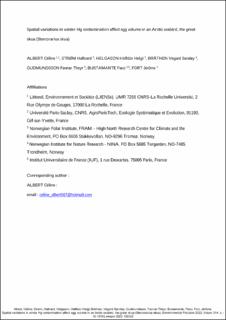| dc.contributor.author | Albert, Céline | |
| dc.contributor.author | Strøm, Hallvard | |
| dc.contributor.author | Helgason, Halfdan Helgi | |
| dc.contributor.author | Bråthen, Vegard Sandøy | |
| dc.contributor.author | Gudmundsson, Fannar Theyr | |
| dc.contributor.author | Bustamante, Paco | |
| dc.contributor.author | Fort, Jérôme | |
| dc.coverage.spatial | North Atlantic, Bjørnøya, Svalbard | en_US |
| dc.date.accessioned | 2022-11-23T09:08:44Z | |
| dc.date.available | 2022-11-23T09:08:44Z | |
| dc.date.created | 2022-11-14T11:56:25Z | |
| dc.date.issued | 2022 | |
| dc.identifier.issn | 1566-0745 | |
| dc.identifier.uri | https://hdl.handle.net/11250/3033552 | |
| dc.description.abstract | Knowledge of the ecology and at-sea distribution of migratory species like seabirds has substantially increased over the last two decades. Furthermore, an increasing number of studies have recently focused on chemical contamination of birds over their annual cycle. However, the understanding of the combined effects of spatial movements and contamination on seabirds’ life-history traits is still scarce. During winter, seabirds can use very different areas, at the large-scale. Such overwintering strategies and distribution may expose individuals to contrasting environmental stressors, including pollutants. Here, we studied the winter distribution and contamination with mercury (Hg), and their combined effects on reproduction, in a great skua (Stercorarius skua) population breeding in Bjørnøya, Svalbard. We confirmed that individuals of this specific population overwinter in three different areas of the North Atlantic, namely Africa, Europe and northwest Atlantic. The highest Hg concentrations in feathers were measured in great skuas wintering off Europe (Linear Mixed Models - mean value ± SD = 10.47 ± 3.59 μg g 1 dw), followed by skuas wintering in northwest Atlantic (8.42 ± 3.70) and off Africa (5.52 ± 1.83). Additionally, we found that female winter distribution and accumulated Hg affected the volume of their eggs (Linear Mixed Models), but not the number of laid and hatched eggs (Kruskal-Wallis tests). This study provides new insights on the contamination risks that seabirds might face according to their overwinter distribution and the possible associated carry-over effects. Mercury Reproduction Spatial ecotoxicology Biologging Carry-over effects | en_US |
| dc.language.iso | eng | en_US |
| dc.subject | Forurensning | en_US |
| dc.subject | Pollution | en_US |
| dc.subject | Kvikksølv | en_US |
| dc.subject | Mercury | en_US |
| dc.title | Spatial variations in winter Hg contamination affect egg volume in an Arctic seabird, the great skua (Stercorarius skua) | en_US |
| dc.title.alternative | Spatial variations in winter Hg contamination affect egg volume in an Arctic seabird, the great skua (Stercorarius skua) | en_US |
| dc.type | Peer reviewed | en_US |
| dc.type | Journal article | en_US |
| dc.description.version | acceptedVersion | en_US |
| dc.subject.nsi | VDP::Matematikk og naturvitenskap: 400 | en_US |
| dc.subject.nsi | VDP::Mathematics and natural scienses: 400 | en_US |
| dc.subject.nsi | VDP::Matematikk og naturvitenskap: 400 | en_US |
| dc.subject.nsi | VDP::Mathematics and natural scienses: 400 | en_US |
| dc.source.volume | 314 | en_US |
| dc.source.journal | Environmental Pollution | en_US |
| dc.identifier.doi | 10.1016/j.envpol.2022.120322 | |
| dc.identifier.cristin | 2073419 | |
| dc.relation.project | Norges forskningsråd: 192141 | en_US |
| dc.relation.project | Andre: French Agency for National Research | en_US |
| dc.source.articlenumber | 120322 | en_US |
| cristin.ispublished | true | |
| cristin.fulltext | postprint | |
| cristin.qualitycode | 1 | |
